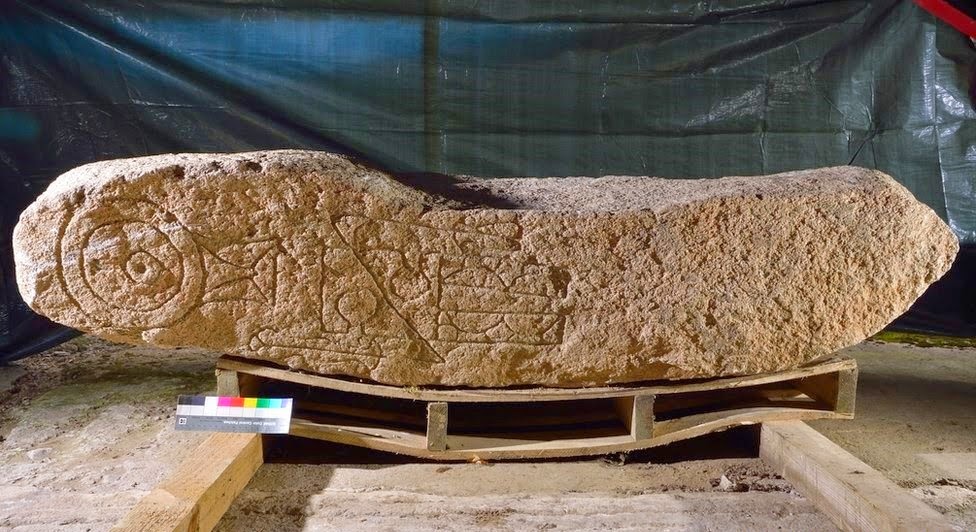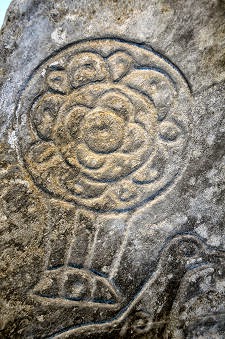caso, una località mal pronunciabile presso Inverness) è stato
trovato uno scheletro incompleto, presumibilmente di
maschio quasi adulto, accompagnato da alcuni frammenti
ceramici (2/3 di un beaker alto 20-30 centimetri, il cui
interno conteneva 'qualche cosa di organico' che sarà
analizzato accuratamente ed il cui esterno appare essere
stato decorato forse con una penna d'uccello). Oltre a ciò
(datato a partired ai resti ossei a 4.000-5.000 anni fa, cioé
alla prima età del Bronzo) è stato rinvenuto un 'parapolsi'
('wrist-guard' in Inglese e 'brassard' in francese). Lo si è
dedotto dalla forma dell'oggetto e dal fatto che presenta fori
che sembrano proprio quelli atti a fare passare legacci di
cuoio per fissare il parapolsi all'avambraccio dell'arciere. I
reperti sono stati fotografati, registrati e quindi spediti ai
laboratori che ne eseguiranno accurate ed approfondite
analisi.
Che cosa c'è di strano? Nulla, credo...
Forse il fatto che nessuno - in Scozia - si è presentato per
leggere il nome di Yahweh nei buchi del brassard...
Ma - si sa - gli Scozzesi non hanno alcuna fantasia: forse gli
avrebbero riso dietro...
E credo proprio che avrebbero avuto ragione...
Remains of Bronze Age bowman found in
Scotland
Archaeologists have discovered new artefacts suggesting a Highland village resident of 4,500 years ago fought with bow and arrow.
Holes in the wrist guard could be for leather bindings
[Credit: AOC Archaeology]
A Bronze Age burial cist in Drumnadrochit, near Inverness, was found last month, and researchers have now found shards of pottery and a wrist guard, for use when shooting using bow and arrow, at the same site.
Now work is being done to glean as much information about the finds, and it’s hoped they’ll be able to determine the gender of the skeletal remains.
The initial discovery was made when workers were preparing the site of NHS Highland’s £1.5 million replacement Drumnadrochit Health Centre.
Mary Peteranna, of AOC Archaeology Group, has been working on what she described as "significant" finds for NHS Highland.
She said: "The shards are of around two-thirds of a beaker pot which will probably have been around 20-30cm high. What makes them particularly interesting is that there is some organic material adhering to the base of the pot, so we may find out something about its contents.
Archaeologists believe the pottery may have been decorated with a feather quill
[Credit: AOC Archaeology]
"The wrist guard is also particularly exciting.
It has holes so that it could be tied to the wrist with a leather strap, and may have been ornamental or functional."
Heather Cameron, senior project manager with the health board, said: "It is perhaps fitting that the site of what will be Drumnadrochit’s newest public building should have had the remains of what may well have been the community’s first resident. The skeletal remains are 4,000-4,500 years old, dating back to the early Bronze Age.
"We are particularly excited to have uncovered the pottery and wrist guard in what appeared to be a second grave next to the first, and I think we will be looking to mount a display on the finds somewhere in the new building when it opens at the end of the year."
The skeletal remains, which may be of an adult or near adult, comprise of most of a person’s long bones along with part of the skull and a number of teeth.
It is hoped to be able to determine scientifically the sex of the person, and perhaps even the cause of death.
The artefacts have been photographed, recorded and removed and will now be undergoing specialist, detailed analysis.
A decision will then be taken about what to do with them.
Author: Nick Humphreys | Source: Highland News [February 05, 2015]











